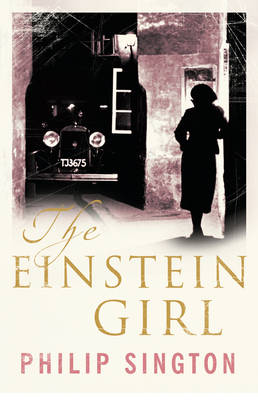
EURO CRIME
Reviews

Sington, Philip - 'The Einstein Girl'
Hardback: 400 pages (Aug. 2009) Publisher: Harvill Secker ISBN: 1846552907
In the complex start of THE EINSTEIN GIRL we first read a letter to Elisabeth about a novel that the writer wants published after his death, then we are taken to Berlin in May 1933 as Alma Siegel searches for her missing fiance, psychiatrist Martin Kirsch.
Martin had been treating a young woman found half-naked in the woodlands near Potsdam. Near her body there had been found handbill advertising a lecture entitled "The Present State of Quantum Theory" and the principal speaker was Professor Albert Einstein. The young woman who was suffering from amnesia was naturally dubbed the 'Einstein Girl' by the popular press.
In a further flashback to October 1932 (the main part of the book) we follow Martin Kirsch in his work at the Charite Psychiatric Clinic in the months leading up to his disappearance. We learn about his disagreements with his superior Dr Heinrich Mehring over the treatment of patients, his meeting with the Einstein Girl before she is found in the woodlands, the loss of his brother Max in the Great War and the wealth and influence of Alma's family.
As Martin treats the beautiful Einstein Girl she remembers her name - Mariya, although when they had met briefly before the incident she had told him her name was Elisabeth - and he begins to fall in love with her. He finds the room where she was living as Mariya Dragonovic, and a notebook with complex mathematical calculations. He takes the notebook to Nobel Prize winner Professor Max Von Laue and from him learns that only two women could absorb Albert Einstein's work as readily as in his patient's notebook. They are Marie Curie and Mileva Maric, a Serbian, who was Einstein's first wife and is now teaching in Zurich.
In his quest to explore Mariya's past, explain her amnesia and confirm her identity Martin travels to Switzerland to meet Mileva Maric, and also Eduard Einstein the professor's son, a patient in a psychiatric clinic. Is Mariya Dragonovic the long lost Liserle (Elisabeth), Albert Einstein and Mileva Maric's daughter conceived out of wedlock? In a sub-plot we learn about Mariya Dragonovic's childhood and former life and the threads of these plots converge to a dramatic and perhaps surprising conclusion.
This complex novel is a brilliant mystery with an intelligent narrative that raises those key questions that keep you turning the pages. What has happened and what will happen? The reader learns a little bit about the primitive psychiatry of the time, while the characters are strongly drawn and you get a real feel for what life was like working in Germany in that period. The reader is brought face to face with the trauma and the shame of the deaths of so many young men in the Great War, including Martin's brother Max, all wasted in a beaten cause. The story also reminds us of the fragility of the human mind, and how tenuous our hold on reality can be at times of extreme stress.
The use of the real life characters in crime fiction does not usually concern me when the subjects are evil people, but I have some reservations about the use of Albert Einstein, voted person of the century by Time magazine, because he does not come over very sympathetically, and perhaps this is the price of his genius: an inability to relate to human beings. But help with the meticulous research that has gone into the story came from the Albert Einstein Archive in Jerusalem and you can't argue with the facts.
The superb storytelling, great characters, both real and fictional, and especially the historical notes at the end which inform us about the 400,000 people who underwent involuntary sterilisation, and the 250,000 mentally and physically handicapped people who were murdered by the Nazi regime under their racial hygiene laws make this book a compelling and worthwhile read.
Even though it covers the complex subjects of psychiatry, quantum physics, unrequited love, the vulnerability of women, and the Nazi race laws, don't be put off, it is actually a very easy to read book.
Albert Einstein finally left Germany for America in October 1933, many other physicists were to follow him into exile over the next decade including Niels Bohr, Enrico Fermi, Lise Meitner, Otto Robert Frisch, Hans Bethe, Emilio Segre, Bruno Pontecorvo, Eugene Wigner, Leo Szilard, John von Neumann and Edward Teller. I am very thankful that these brilliant minds were not available to the Axis war effort.
Norman Price, England
August 2009
More European crime fiction reviews can be found on the Reviews page.